Caterpillars are insects about to become butterflies or moths. Florida is one of the states with very high caterpillar populations.
A combination of warm weather with a humid subtropical profile makes Florida an ideal habitat for a large range of caterpillars.
Some of the caterpillars encountered here are harmless while others bite.
All of them feed on various species of plants with or without major impact consequences.
Some caterpillars in Florida also live in nearby states of Georgia, Alabama, Louisiana, as well as Texas.
They often feed on Passiflora genus plants and other plants and flowers that live in humid environments.
Table of Contents
1. Gulf Fritillary Caterpillar
Gulf Fritillary caterpillars (Dione vanillae) are a common sight in sunny open areas of Florida. These caterpillars are tied to flowers of the Passiflora genus which are known as passion flowers.

The caterpillar has an orange-brown color with long black lines across its dorsum.
Caterpillars of this genus are wrongly believed to be poisonous due to their long black spikes that cover their bodies.
These spikes aren’t dangerous as they only serve a purely visual purpose to deter potential predators.
The larvae or caterpillar stage of this species lasts at least a week. During this time, the colorful caterpillar is seen eating either entire leaves or leaves edges of its host plant.
2. Monarch Caterpillar

Monarch Caterpillars (Danaus plexippus) are a common sight in milkweed around Florida.
There are 2 methods to identify this species of milkweed. You can analyze its colors and body size or you can look out for eaten milkweed leaves as this caterpillar eats them with circular movements.
Monarch caterpillars have a banded body of just over 1 inch that goes through 5 instars. These caterpillars have long black antennae and a black head.
White, black, and yellow bands are seen on its body.
It takes up to 5 days for the Monarch caterpillar to go through all of its instars and grow.
You can also check out milkweed plants for damage as these caterpillars exclusively feed on milkweed leaves.
The spiral-shaped damage created to plants comes from the circular movements and eating patterns of this caterpillar.
3. White Peacock Caterpillar
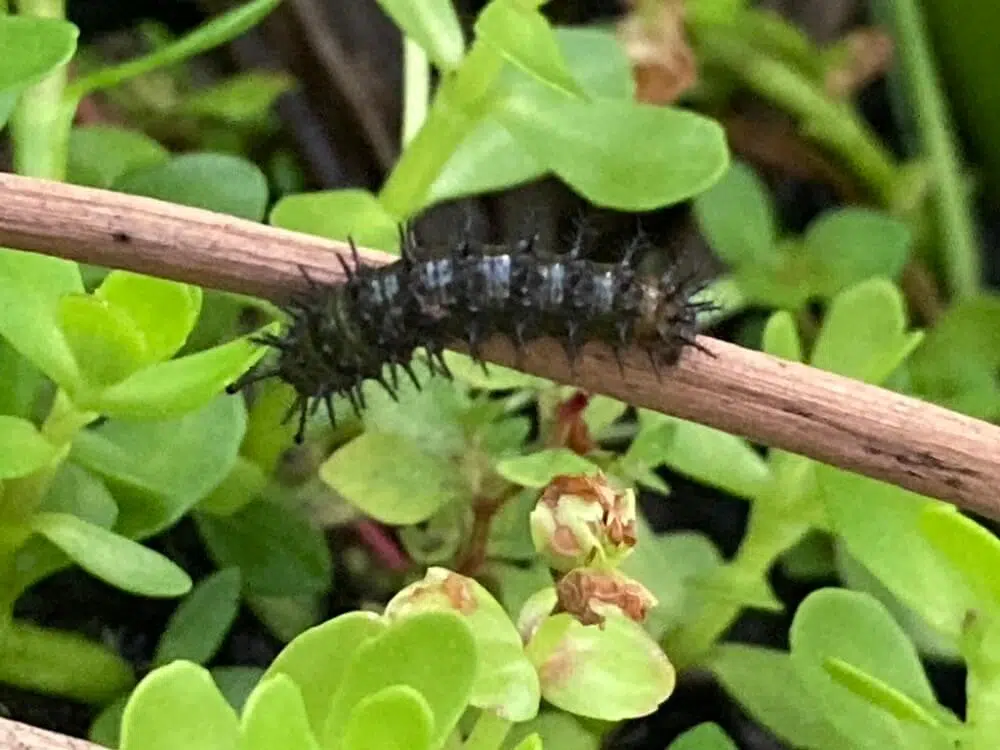
White Peacock caterpillars (Anartia jatrophae) are native to Southeast US. The species can be found in Texas, Louisiana, Alabama, Georgia, and Florida.
Caterpillars of this genus live on host plants such as water hyssop.
This is a species tied to water sources. This is why White Peacocks are mostly found on the edges of ponds, lakes, and streams.
A study shows abundant populations of the caterpillar in Central Texas while current data suggest the species is the highest in numbers in Florida.
While its name suggests a white color, this caterpillar is all-black. It has a long black body with long black spikes.
Just before reaching its maximum size of 35mm, this caterpillar changes the color of its black spikes to red spikes.
4. Zebra Longwing Caterpillar

Zebra Longwing caterpillars (Heliconius charithonia) are among the few caterpillars which have the same colors as the adult butterfly of the species.
As the name of the species implies, this caterpillar has a black and white color combination.
As the black and white Zebra Longwing butterfly, the Zebra Longwing caterpillar has a white body with tiny black spots all over it.
Small black spikes are seen all over the body of the species.
Like many US caterpillars, Zebra Longwing caterpillars feed and live on passionflower. These are a series of yellow plants the Zebra Longwing larvae grow on.
These flowers have short hairs which can be painful to some species such as insects and even humans. However, this long black and white caterpillar feeds on the plants regardless.
It eats the protective hairs of passionflowers or lays a silk-like material on them so that it can move on the plant without discomfort.
5. Common Buckeye Caterpillar
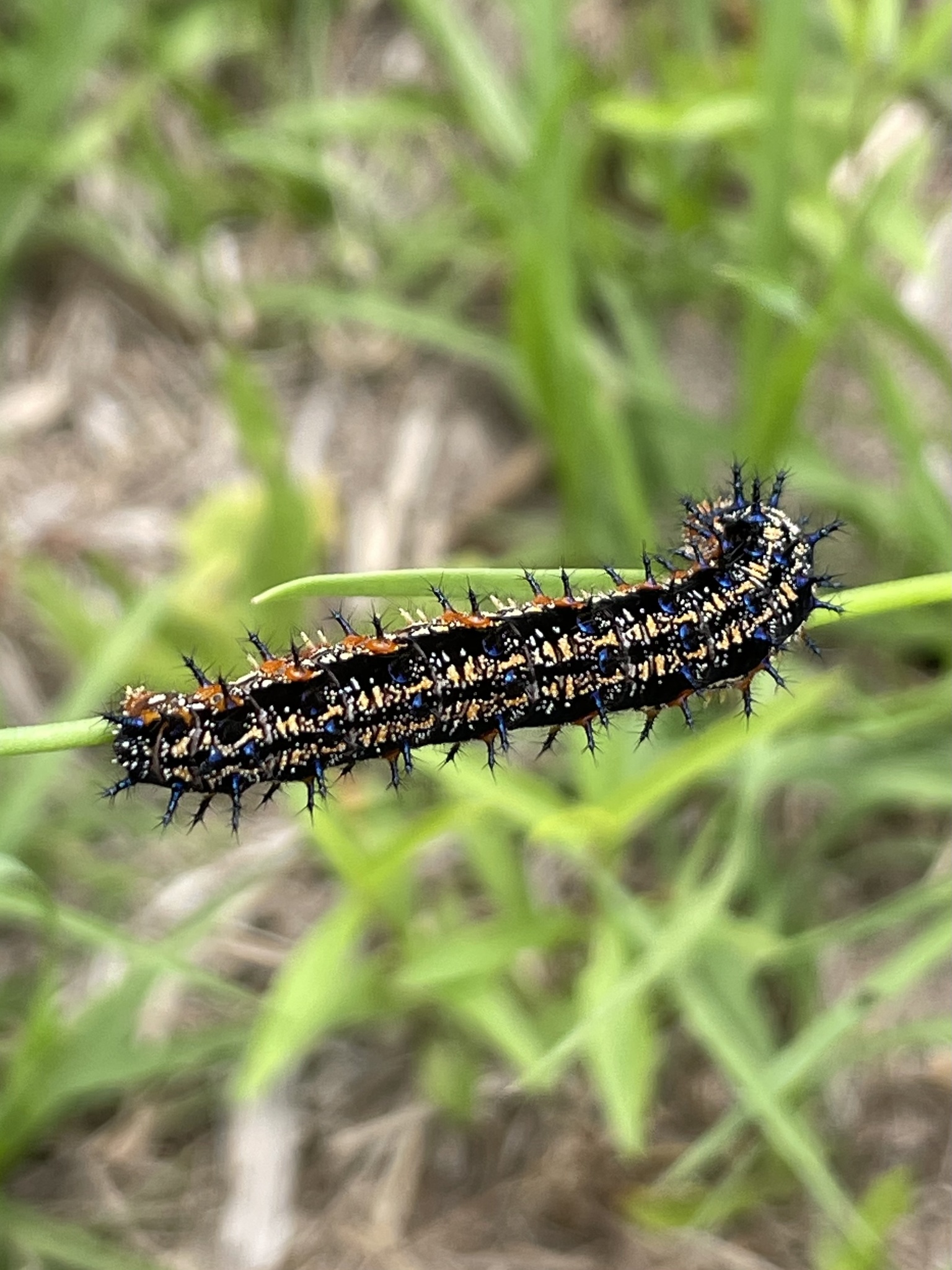
The caterpillars of the Common Buckeye species (Junonia coenia) are some of the most researched in Florida given their common nature.
This species is most interesting due to its coloring and its innate capacity to keep predators such as ants away.
Caterpillars of the genus have brown and black stripes that run from head to tail with white lateral bands and black spines all over the body.
This coloring makes the caterpillar stand out on the green plants and flowers it lives and feeds on.
Common Buckeye Caterpillars are found on buckhorn and similar plants due to a certain peptide these plants produce.
A certain sugary peptide buckhorn makes aids the digestive system of the caterpillars. It also helps the body of caterpillars develop a certain level of immunity against a wide range of predators.
As adults, these insects are known to visit multiple types of special yellow flowers and flowers that tend to change their coloring as a direct impact of caterpillars and other insects that live and feed off them.
6. Horace’s Duskywing Caterpillar
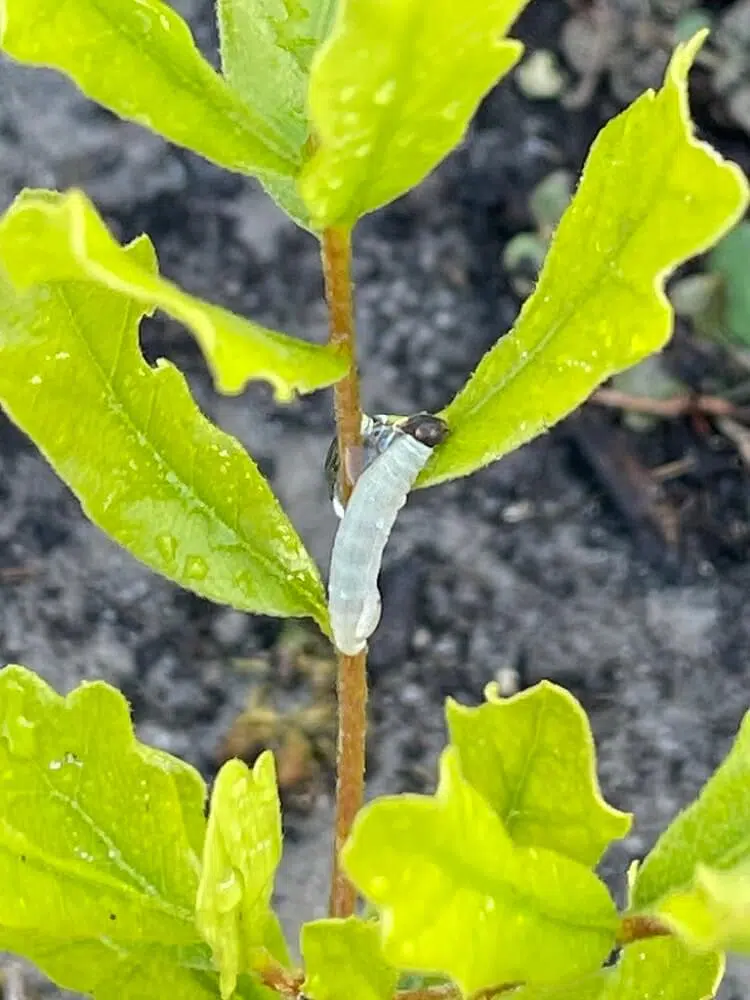
A pale green body with an orange-red head is specific to Horace’s Duskwing caterpillar (Erynnis horatius).
This species is found on oak trees of various families in Florida.
Its range is considerably wider, on the other hand. Horace’s Duskywing caterpillars are found in the entire Eastern US region on oak trees.
While adults don’t feed on oak trees, caterpillars are always seen on the leaves of these common North American trees.
Red and white oaks are known to be the preferred oak tree species for the caterpillars.
As adult butterflies, Horace’s Duskywing butterflies retain a wood-like tan to a brown color similar to various oak trees.
7. Long-tailed Skipper Caterpillar

Long-tailed Skipper caterpillars (Urbanus proteus) are one of the common pest caterpillar species in Florida and other states.
This species is a considerable problem for beans. It finds its way to bean leaves and it shelters in a leaf which it rolls around itself.
Each caterpillar attacks a bean leaf with the potential of drying out the plant in case of serious invasions. Caterpillars of this genus have a similar coloring to the bean leaf.
They have a green body with yellow bands and stripes. The head is black.
There are multiple control methods farmers in Florida consider against this invasive species.
The easiest or least impactful method to control the Long-tailed Skipper caterpillar population is by introducing predatory bugs, a solution adopted in organic farming.
Predatory bugs that feed on these caterpillars include the Florida Stink bug.
You know beans in your garden might be impacted by this caterpillar if you see a green, black and orange bug with a shield shape body which is the Florida Stink bug.
8. Eastern Giant Swallowtail Caterpillar

Eastern Giant Swallowtail caterpillars (Papilio cresphontes) are known for their invasive profile. They are found on citruses such as oranges all the time.
These caterpillars are some of the most resilient in Florida due to a growing range of natural predators which include spiders, birds, and other vertebrates.
Eastern Giant Swallowtail caterpillars adapt coloring that mimics bird droppings so they improve camouflage while on their preferred host leaf.
This means the species is perceived as bird droppings by many of its predators rather than as a caterpillar.
The shape and coloring of the species embody this camouflaging technique as many overlook it without thinking it’s an actual caterpillar.
The species has yellow and brown coloring and an irregular-shaped body, unlike most other caterpillars.
Its irregular shape body only has white spikes in the first instar but these spikes aren’t visible in other instars.
The caterpillar has been shown to thrive on citruses and to develop at a slower rate on other hosts.
9. Fiery Skipper Caterpillar
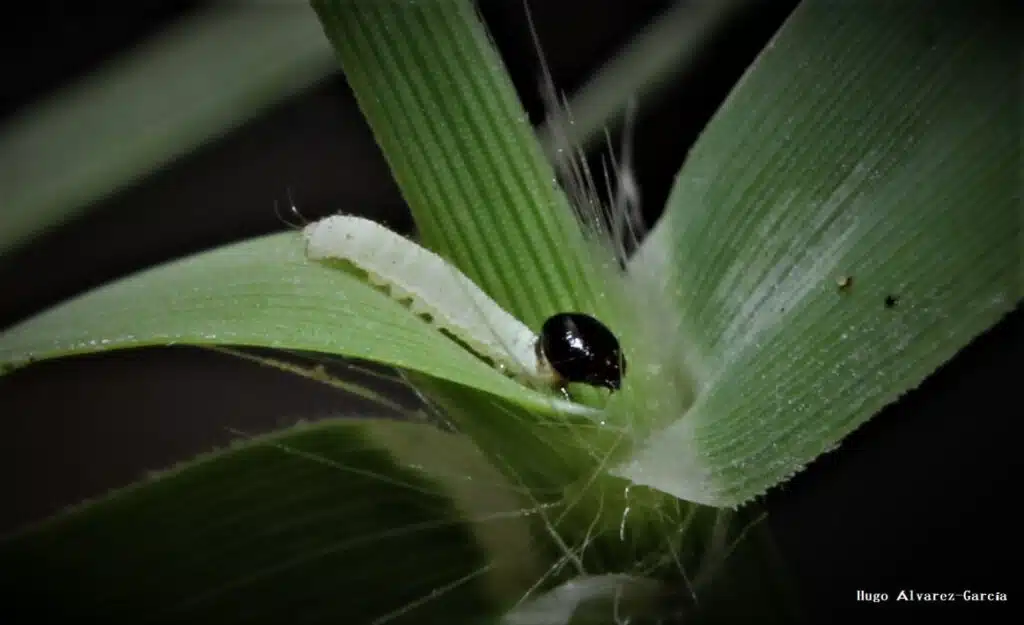
This caterpillar is one of the Florida species with a widespread distribution.
Once believed to be a small species, the Fiery Skipper caterpillar (Hylephila phyleus) is one of the common reasons people start thinking about turf pest control in Florida and beyond.
The pink caterpillar feeds on grass, Bermuda grass, and St. Augustine grass. All of these ornamental grasses are commonly found in warm climates such as Florida and Hawaii.
The caterpillar has a considerably wider distribution from South America down to Argentina.
Adults of the species are known pests of bananas.
There are multiple methods of reducing or controlling Fiery Skipper caterpillar populations.
However, studies suggest only insecticides are completely efficient against this caterpillar which can hide at the root of certain ornamental grasses.
10. Queen Caterpillar

The adult Queen caterpillar (Danaus gilippus) is known for coming in various colors.
It has distinctive bands across its body which is black, white, yellow, or blue. When it reaches its maximum size, the Queen caterpillar also has 2 yellow dots on the black lines across its body.
This species has a smooth body without any hairs or any other type of spines.
Many would believe it to be defenseless in the face of predators.
However, the Queen caterpillar has a bad taste which makes birds and other predators spit it out quickly.
Caterpillars of this genus are known for living on various plants including milkweeds.
Things change when the caterpillar becomes an adult butterfly as milkweeds aren’t its favorite anymore in the favor of Nerium flowers.
11. Ceraunus Blue Caterpillar
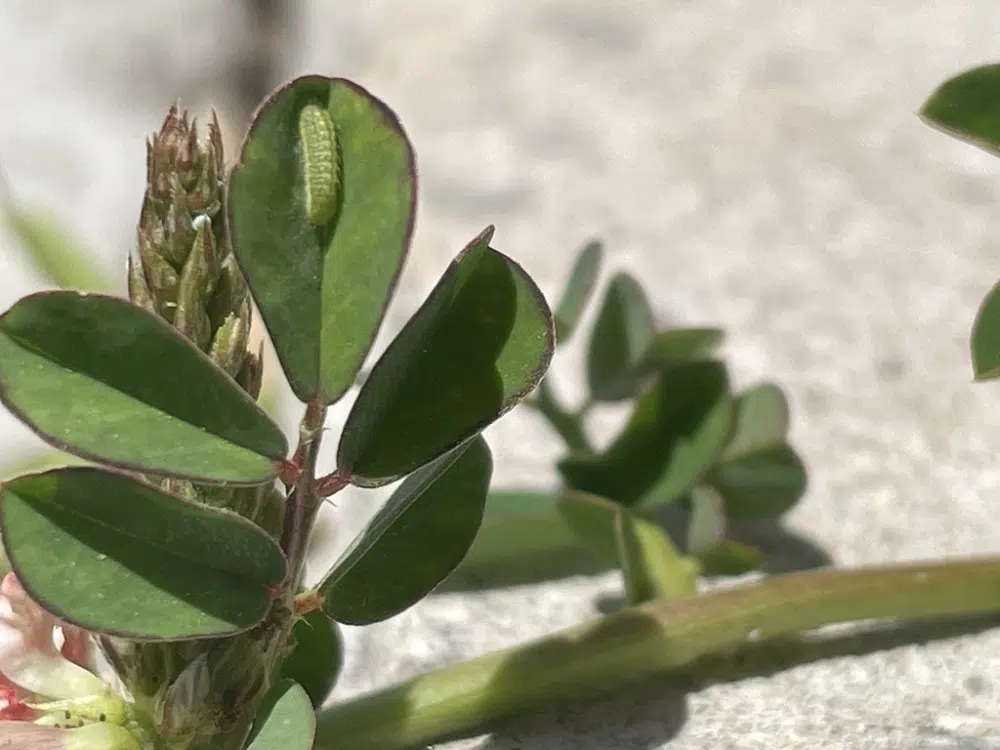
Ceraunus Blue caterpillar (Hemiargus ceraunus) has a widespread distribution in Southern US states.
It has a considerable distribution in California, Nevada, Texas, and Florida.
The Ceraunus Blue caterpillar is among the most damaging types of caterpillars native to Florida.
This species is considered a pea pest.
It feeds on various types of peas including rosary peas.
You can identify the caterpillar by its green body and black head. These caterpillars also have a fine yellow line on each side of their body.
Caterpillars of this family feed on both the flowers and the seedpods of woody legumes such as peas.
Insecticidal control is recommended when it comes to eliminating them.
12. Black Swallowtail Caterpillar
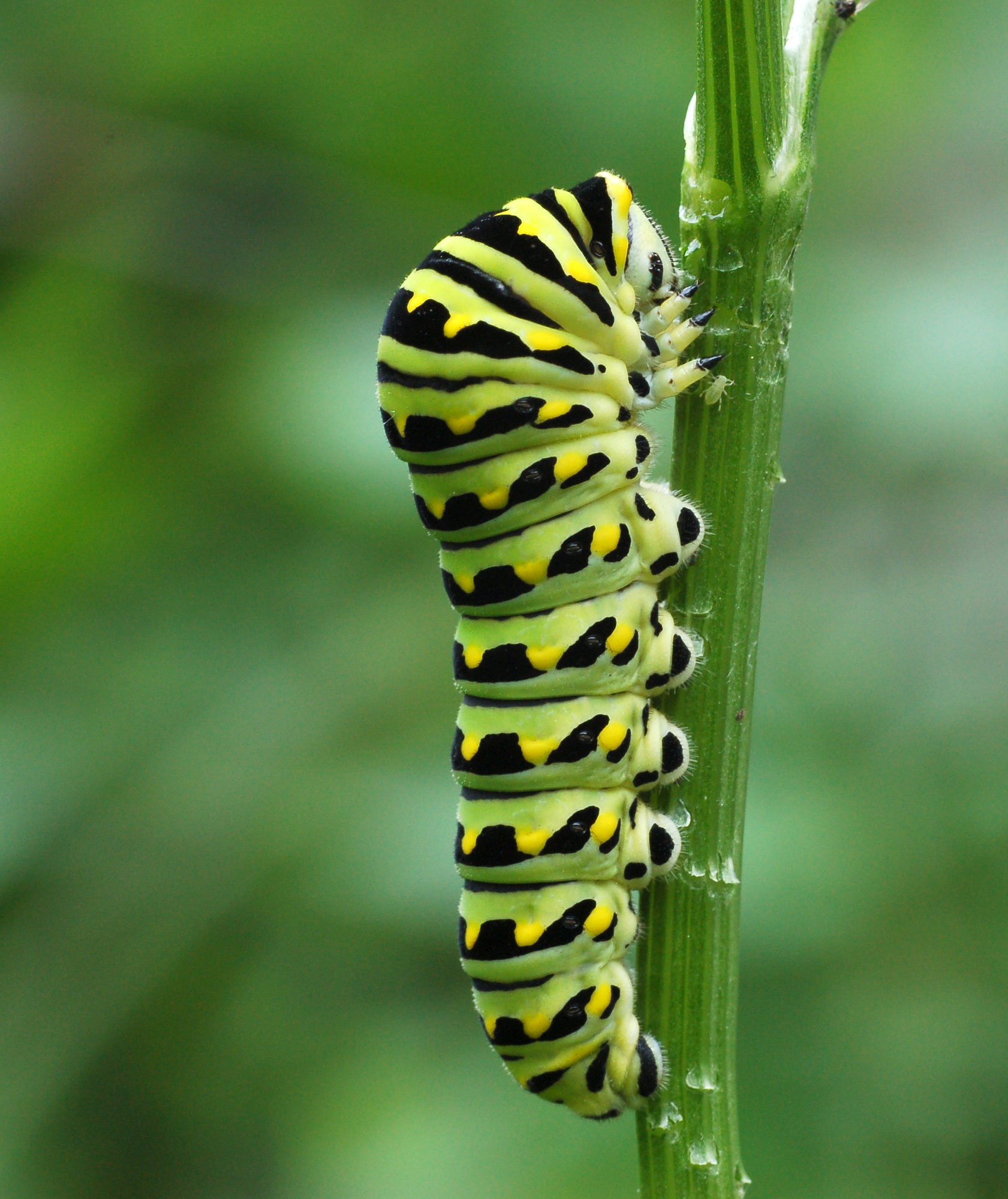
Black Swallowtail caterpillars (Papilio polyxenes) look completely different from adult butterflies.
They aren’t black but mostly green with black and yellow marks on their bodies without spikes.
These caterpillars are very common on all types of plants but young plants or new foliage are preferred by the species to other types of plants.
These caterpillars are some of the most versatile in Florida when it comes to absorbing toxins from a wide range of plants.
Caterpillars of the genus absorb all types of toxins which essentially make them taste bad.
Predators know they taste bad and move along. Furthermore, their naturally-green color allows them to maintain camouflage when sitting on plant leaves.
This caterpillar has a long life before turning into chrysalis which is a state in their lifecycle they remain in during the entire winter.
13. Atala Caterpillar

Atala Caterpillar (Eumaeus atala) is native and almost exclusive to Florida. The warm subtropical habitat here allows the species to thrive.
The caterpillar is identified by its distinct red body. It also has a few yellow dots along its dorsal side.
A combination of a red body with yellow dots makes the caterpillar appear poisonous to its predators which tend to leave it be.
The caterpillar still absorbs all toxins of its host plant so that it tastes bad. Even if predators might be tempted to eat the caterpillar once, they will not come back after the species due to its bitter taste.
Caterpillars of this genus are highly common on a type of small palm-like tree found in Florida known as the Coontie palm.
This palm tree has long green leaves the caterpillar feeds on. Newly-emerged leaves are known to be particularly attractive for the species.
14. Io Moth Caterpillar

Io Moth caterpillars (Automeris io) should be avoided as they are venomous.
There’s no clear scientific evidence of just how dangerous their venom is to humans. However, it’s believed its venom can still be painful to people.
Io Moth caterpillars are known to sting. They are aggressive and tend to sting whenever handled with bare hands.
Caterpillars of the genus are further known for having spikes that are also painful.
Furthermore, the spikes of this caterpillar penetrate the skin and remain stuck until you manually remove them.
You can identify this species by its mostly green body color.
Young caterpillars of the genus are either yellow, orange, or red. Just as mature caterpillars, the young can also sting and they’re also venomous.
These caterpillars are found on a Florida-specific plant known as Coral bean in the state or a Cherokee bean elsewhere.
15. Great Southern White Caterpillar
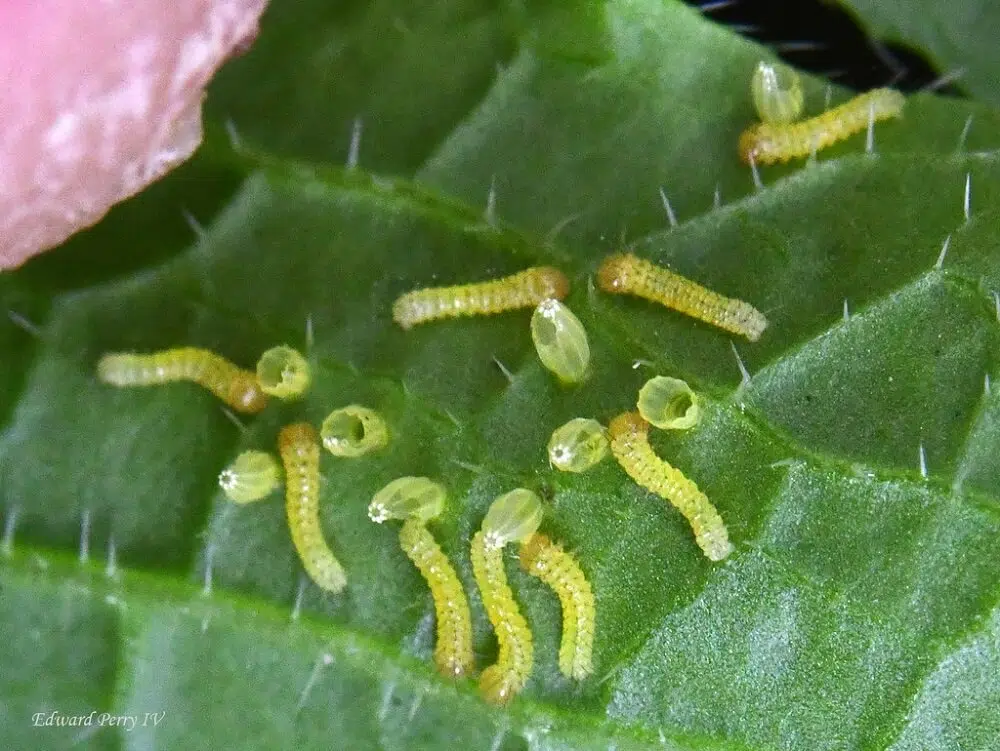
Great Southern White caterpillars (Ascia monuste) have a base green color with yellow stripes and small black dots. The caterpillar has a black head and rare black hairs.
This species is common in Florida and Southeastern US.
It’s considered a pest on many types of crops and it’s a sign you might need to take action with insecticide.
Unlike adults, caterpillars are a common sight on mustard as well as on other vegetables such as radish.
Adults move along to feeding on the nectar of plants such as saltwort.
16. Eastern Tiger Swallowtail Caterpillar

Eastern Tiger Swallowtail caterpillars (Papilio glaucus) are green as young caterpillars. They then turn brown and they exhibit yellow lines and black spots across their bodies before turning green again.
These caterpillars are very common in Florida and typically share the same host plant with adults which feeds on its nectar.
Many types of caterpillars in Florida feed on other plant leaves compared to the plants preferred by adults.
The Eastern Tiger Swallowtail has a preference for pink or red flowers in the dogbane family.
17. Polyphemus Moth Caterpillar

Polyphemus Moth caterpillars (Antheraea polyphemus) are known for their capacity to eat large amounts of food.
They spend a total of around 2 months in a caterpillar stage due to their high eating frequency.
Caterpillars of this genus can eat a few thousand times their body weight.
They start their lives as green caterpillars and then turn to dark green and brown caterpillars.
These caterpillars molt 5 times. During this time, they also develop small red spots on their bodies which makes them appear highly poisonous.
Caterpillars of this genus final settle in an oak leaf which is used for the molts.
18. Cloudless Sulphur Caterpillar

Cloudless Sulphur caterpillars (Phoebis sennae) have a different host plant to the adult butterflies but share a high resemblance in coloring.
The caterpillar has a vivid yellow color with just a few black dorsal bands.
This species is easy to spot on its host plants which are peas, clovers, or other vegetables.
Considered pests, these caterpillars can represent a considerable problem as they tend to multiply quickly.
Few natural predators exist for this species, mainly due to its coloring.
The vivid yellow color of the caterpillars makes them appear highly poisonous and this makes birds and bugs move along.
Adults of the species maintain the same yellow color with a slightly pale nuance.
Adults also have small black or brown spots on the wings which means they aren’t completely yellow as the caterpillars.
Cloudless Sulphur Caterpillars can have varying sizes after their final molt. They can grow up to 1.8 inches.
19. Barred Yellow Caterpillar
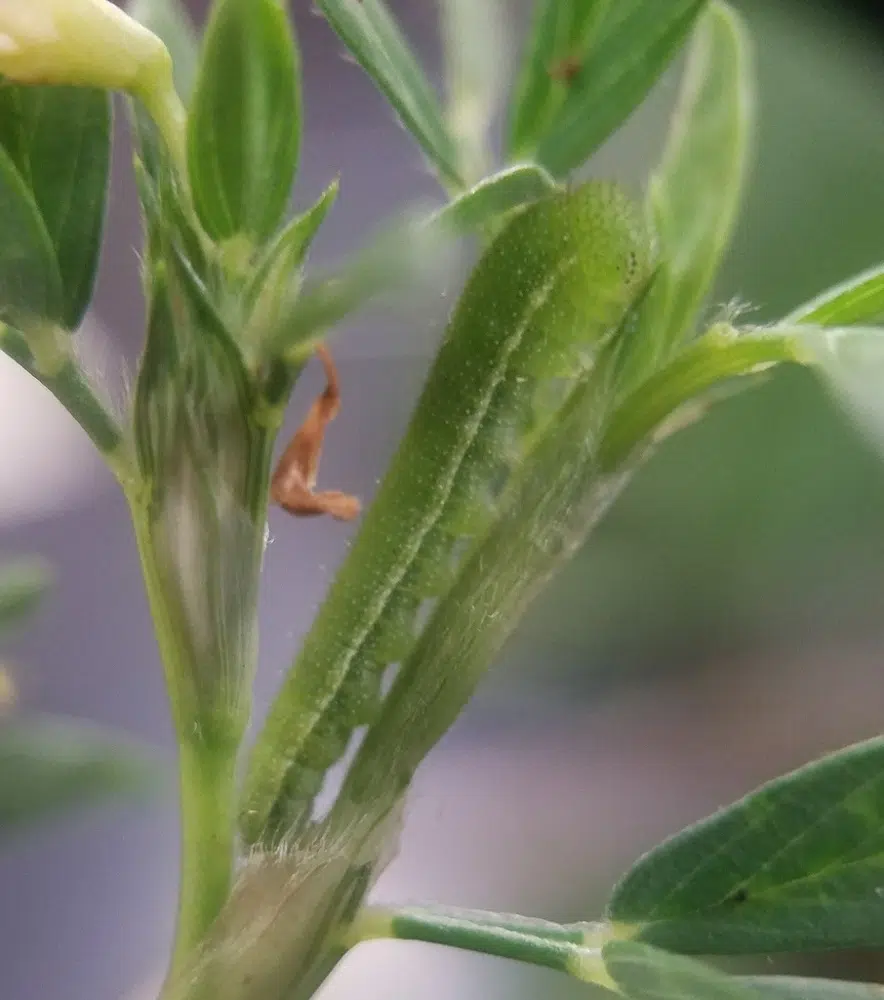
Abundant in tropical and subtropical climates, the Barred Yellow caterpillar (Eurema daira) is also present in Florida.
The species has an expanding habitat in Arizona.
Barred Yellow caterpillars are green with lateral yellow stripes.
These caterpillars feed on various pea-genus flowers such as pencil flowers.
Adults also feed on the nectar of these flowers.
20. Polka-Dot Wasp Moth Caterpillar

Polka-Dot Wasp Moth caterpillars (Syntomeida epilais) abound in Florida.
These caterpillars can be perceived as dangerous and poisonous given their color.
Polka-Dot was Moth caterpillars have the longest bristle hairs of all caterpillars in Florida. These hairs can be as long as 1 inch.
Black bristle-like hairs expand from the sides of the caterpillar and many predators consider them dangerous.
In reality, these are long hairs that do no harm. They don’t sting and they don’t cause skin rashes.
The body of the caterpillar has a bright orange color. It also has small black dots which make the species appear even more poisonous.
Caterpillars of this genus mostly feed on oleander flowers which can be a pest.
The amount of damage the Polka-Dot Wasp Moth caterpillar does to Oleander plants varies considerably. It can bite small areas of their leave or kill entire plants.
21. Fir Tussock Moth Caterpillar

The Fir Tussock Moth caterpillar (Orgyia detrita) is one of the most colorful species in Florida.
It has a multicolored body and bristles of various lengths and colors.
This caterpillar has a green body that grows to 1.5 inches. It exhibits tiny orange spots that make it look poisonous.
A red color head further makes this species appear poisonous.
Black long bristles are seen on the caterpillar.
These are then matched with other-length bristles that also have other colors.
Gray color bristles are seen on the species together with dark gray bristle clusters.
These bristles don’t change color like the body of the caterpillar. This species has a yellow-white color which then darkens within days.
22. Monk Skipper Caterpillar
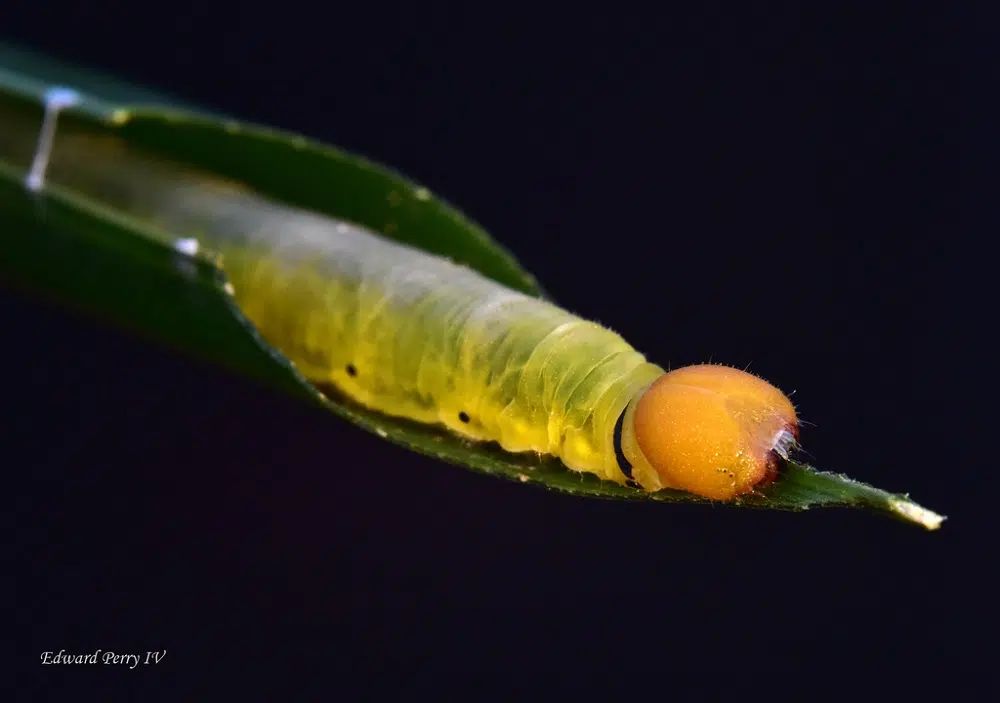
Monk Skipper caterpillar (Asbolis capucinus) shave a dark brown-green color.
They are exclusively found in Florida and the Caribbean due to their preference for palmetto.
Caterpillars of this genus have a dark color that appears almost brown. Resembling adults in brown coloring, the caterpillars like the warm Florida weather.
The highest numbers of Monk Skipper caterpillars are found in Peninsular Florida.
23. Spicebush Swallowtail Caterpillar

The Spicebush Swallowtail caterpillar (Papilio troilus) is one of the mimicking species of Florida.
Caterpillars that engage in mimicry typically look like certain predators to escape being predated.
The Spicebush Swallowtail caterpillar is mostly known for mimicking the Common Garter snake which is one of the larger snakes in the state.
Its mimicry efforts result in a green body with yellow and black dots behind its head that resemble the snake eye.
Smaller yellow dots are also seen on the dorsal of the caterpillar.
If other caterpillars absorb plant toxins as the primary defensive mechanism, the Spicebush Swallowtail caterpillar is mostly known for defending itself through mimicry.
While it takes on some of the colors of the Common Garter snake, the Spicebush Swallowtail caterpillar is still considerably smaller than a young snake as it only measures a couple of inches.
24. Palamedes Swallowtail Caterpillar
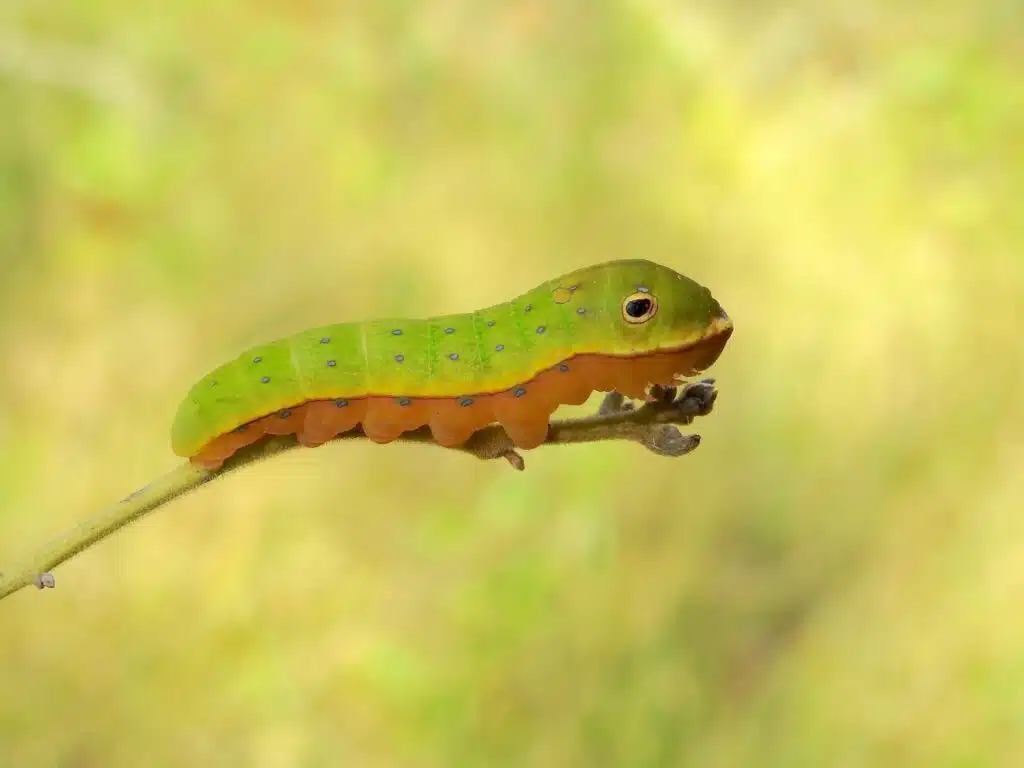
The Palamedes Swallowtail caterpillar (Papilio palamedes) shows similar mimicry traits to the Spicebush Swallowtail caterpillar.
This species is known for mimicking tree frogs.
Caterpillars achieve this by having a green body with yellow stripes on the sides and with a brown underbelly.
The species is further known for its wide eyes on top of its head which resemble the eyes of a frog.
Palamedes Swallowtail caterpillars also mimic having a wide mouth just as frogs have.
While the caterpillar relies on its predators perceiving it as a frog and leaving it alone, it also hides away in leaves.
Caterpillars of the genus curl up in leaves so they escape a wider range of predators.
25. Cassius Blue Caterpillar
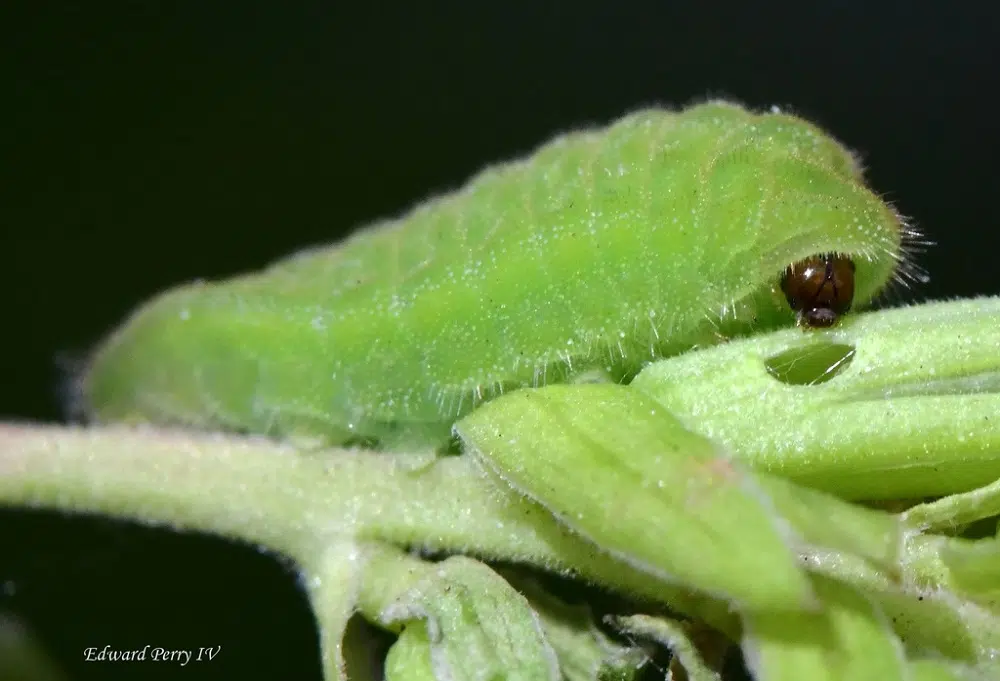
Having a yellow and brown color, Cassius Blue caterpillars (Leptotes cassius) are spreading their distribution outside Florida with decorative flowers.
They live on various plants of the pea family and their presence has already been reported in neighboring states as well.
Native to Florida, the species is known to use ants as a defensive mechanism against a wide range of predators.
These caterpillars live together with ants in a mutually-beneficial relationship.
They eat plant leaves and leave out honeydew with ants to eat. In return, ants keep many potential predators away from the caterpillars.
The size of the caterpillar is small compared to most other species in Florida. A grown caterpillar only measures 0.5 inches.
26. Tersa Sphinx Caterpillar

Common on False buttonweed and other similar flowering plants, this species of caterpillars (Xylophanes tersa) also used mimicry to keep predators away.
Some say it mimics snakes while others say it mimics reptiles.
Tersa Sphinx caterpillar has a long green body. It has brown markings on the sides which mimic snake scales.
Brown spots resembling eyes are seen on its dorsum.
Its head also appears to be a wide-open mouth with teeth.
Caterpillars of the species are found in very high numbers in Florida and other Eastern US states.
27. Julia Heliconian Caterpillar

Julia Heliconian caterpillar (Dryas iulia) lives on Passiflora genus flowers and shrubs.
The species is mostly known for its dark look which is dominated by its dorsum black color.
This species isn’t vividly colored as other caterpillars in Florida which means it has to rely on other defensive techniques if it’s looking to make it into adulthood.
Long bristles are characteristic of this species.
One of the distinct traits of these bristles is their toxins and their sharp shape which resembles small arrows.
People should not handle Julia Heliconian caterpillars with bare hands as the species causes mild skin reactions and even rashes.
28. Viceroy Caterpillar

These pink, white, and dark pink caterpillars (Limenitis archippus) are common in many areas with willows around the state.
Some data suggest the caterpillars also use mimicry to avoid predation while others state their vivid color is independent of other species.
Viceroy caterpillars can be a minor or a major problem for willows.
They tend to appear in the spring when they always feed on fresh leaves of willows.
Caterpillars of the genus prefer to hide on stems or branches once they finish eating due to their dark color camouflage which helps them avoid predation.
29. Ornate Bella Moth Caterpillar

This moth caterpillar (Utetheisa ornatrix) shares its coloring with the adult moth.
Both are orange, black, and white.
The Orante Bella Moth caterpillar gets its name from its vivid orange coloring decorated with black spots.
The larvae of the species start their life with a black-dominant color. Orange is a secondary color.
As the caterpillar reaches its maximum size it has an orange color with partial black dorsal coloring.
Caterpillars of the species are also known for having bristles. However, the number of these bristles is considerably reduced compared to other caterpillars in Florida with bristles.
30. Whirlabout Caterpillar
Caterpillars of the Whirkabout genus (Polites vibex) are known for their damaging role in various grasses.
They eat a wide range of decorative and wild grasses and are typically eliminated by using insecticide.
These caterpillars have a green body and a black head.
Many predators overlook the caterpillars as they mimic the green color of the grasses they live on and which they also eat.
Bermuda grass is one of the most common types of grass the species consumes in Florida.
It also has a widespread presence in Northeast Mexico where it affects similar types of grasses.
31. Zebra Swallowtail Caterpillar

Moist habitats in lowland Florida are the preferred habitat of the Zebra Swallowtail caterpillar (Eurytides marcellus).
This is the habitat where pawpaw, its favorite fruit tree grows.
This caterpillar has a bright green color which is similar to the green color of pawpaw.
It features 3 stripes on its head. A yellow, a black, and a blue stripe are seen together on its head as a distinguishing sign of the species.
Once adult butterflies, they move on to other fruits and nectar for food.
32. Dainty Sulphur Caterpillar
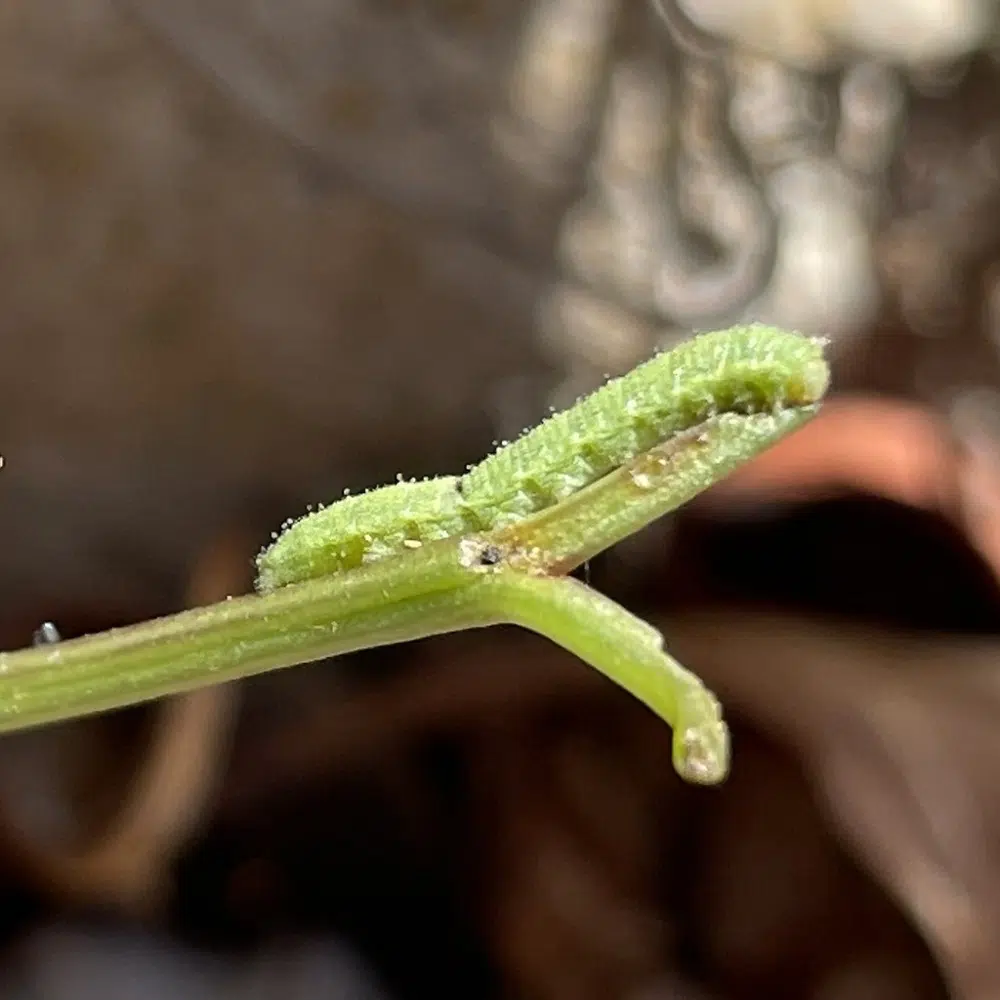
Common on Spanish needles and carpetweed, the Dainty Sulphur caterpillar (Nathalis iole) comes in various colors and patterns.
Most Dainty Sulphur caterpillars have a green base color. Some have dark green almost uniform colors.
Other caterpillars of this genus have a green body with pink, black, or yellow stripes.
This species prefers coastal habitats around the state. It always lives in open areas next to water.
33. Giant Woolly Bear

Giant Leopard moths (Hypercompe scribonia) have a white and black body and a unique contrasting look.
The caterpillar of the species has some resemblance with the adult moth, but to a lesser extent without a white body.
Instead, the giant woolly bear has an almost completely black body with red bands across.
It also has very long setae which is sometimes wrongly believed to be irritating.
Caterpillars of the species are seen on lemon, cabbage, paper flower, and a wide range of other types of host plants.
34. Pearl Crescent Caterpillar

Pearl Crescent caterpillars (Phyciodes tharos) are brown initially. They have white dots and they turn almost completely brown.
These caterpillars are among the few in Florida that have brown setae.
Dogbane and milkweed species are among the favorites of these caterpillars.
Unlike other types of larvae, these caterpillars eat entire leaves by chewing.
Once tuned into adult butterflies, members of the species have a wider diet with a high preference for asters and dogbane.
35. North American Luna Moth Caterpillar

It takes 5 instars for the North American Luna Moth caterpillar (Actias luna) to fully develop.
These caterpillars live solitary lives which means they aren’t pests. The fact they live on their means they cannot infest a host species.
Caterpillars of the genus have a bright green body. Small red dots are seen all over the body.
Brown mouthparts are also visible on the caterpillars.
Yellow spots start to appear on the caterpillar after the 4th instar.
36. Gray Hairstreak Caterpillar

Gray Hairstreak caterpillars (Strymon melinus) are among the few species native to Florida that are also found in almost all other US states.
Its distribution in the country is widespread except in Utah and North Dakota.
Gray Hairstreak caterpillars have a green body with yellow and brown bands on the dorsum.
It feeds on pea and mallow plants.
These feeding preferences change with nectar as adult food.
37. Dorantes Longtail Caterpillar
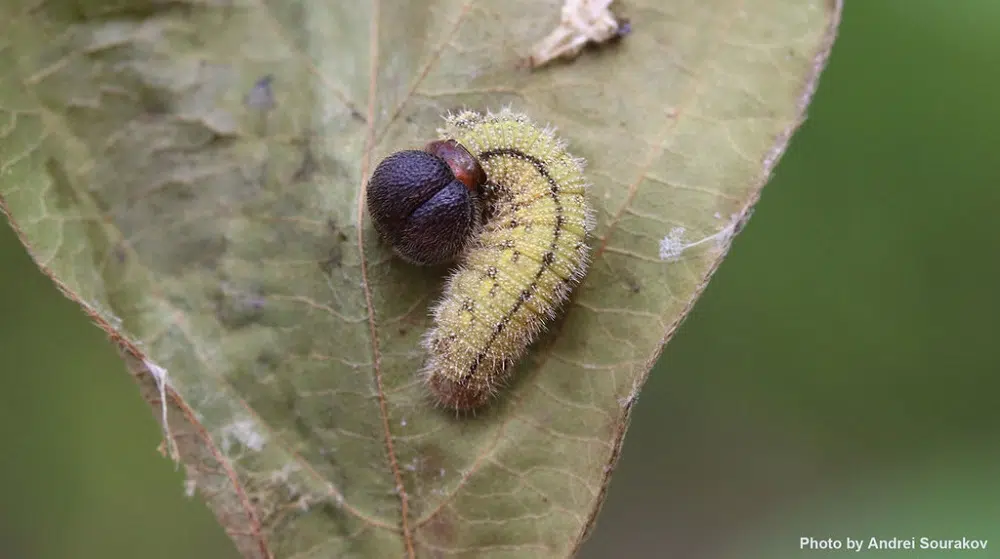
Caterpillars of this genus (Thorybes dorantes) emerge in the spring after adults spend the entire winter in an inactive mode.
Doranted Longtail caterpillars are found all over Florida, in Eastern US states as well as in California.
In Florida, there are up to 4 broods per year.
The most common place to see Dorantes Longtail caterpillars is on beans. It lives on all types of beans but it’s only seen as a mild pest.
Wild bean species are common in overgrown areas with plenty of vegetation, an ideal environment for the Dorantes Longtail caterpillars.
Once emerged into a full adult the food preferences change towards nectar of shepherd’s needle and ironweed.
38. Southern Pink-striped Oakworm

Growing to a size of up to an inch, this species has a dark green color with yellow lines.
This color then evolves into a green base color with silver and red bands on the dorsum.
Short black setae are also specific to the species.
Growing to almost 1 inch in length, this species isn’t solitary.
Southern Pink-striped Oakworms (Anisota pellucida) feed together in small groups.
Oak tree leaves are the most common type of food for the species.
Southern Pink-striped Oakworm moths mate on oak trees. They often mate right on oak tree leaves.
Females lay eggs on these leaves after a full day of being together with the male.
The underside of oak leaves is where these eggs are placed.
Southern Pink-striped Oakworms live in groups which makes them dangerous and a known pest in oak woodlands.